I am trying to create a tee-piece which is a fitting in the plumbing domain. It consist of 2 tubes that are merged together and has 3 openings as shown in this picture.
I have written some code in threejs where I am trying to create a tube mesh1 and another tube mesh2 and then try to union them into mesh3 with the library @enable3d/three-graphics/jsm/csg - thanks to @Marquizzo. After using the function CSG.union and adding the mesh to the scene I can see that I get one tee-piece but it has also created a hole in geometry 1, which was not expected. You can see a picture of the correct holes(green) and the wrongly created hole (red) here:
it should instead look like this and be as one geometry.
Can anyone tell me how CSG works and why I am getting an extra hole on the backside of the first geometry?
import React, { Component } from 'react';
import * as THREE from 'three';
import { OrbitControls } from 'three/examples/jsm/controls/OrbitControls';
import { CSG } from '@enable3d/three-graphics/jsm/csg';
export default class TubeViewer extends Component {
componentDidMount() {
//Add Scene
this.scene = new THREE.Scene();
//Add Renderer
this.renderer = new THREE.WebGLRenderer({ antialias: true });
this.renderer.setClearColor('#808080');
this.renderer.shadowMap.enabled = true;
this.renderer.shadowMap.type = THREE.PCFSoftShadowMap;
this.renderer.setPixelRatio(window.devicePixelRatio);
this.renderer.setSize(window.innerWidth, window.innerHeight);
this.mount.appendChild(this.renderer.domElement);
//Add Camera
const fov = 60;
const aspect = window.innerWidth / window.innerHeight;
const near = 1.0;
const far = 1000.0;
this.camera = new THREE.PerspectiveCamera(fov, aspect, near, far);
this.camera.position.set(1, aspect, 1, 1000);
//Tee-piece
const curve1 = new THREE.LineCurve(new THREE.Vector3(2, 0, 0), new THREE.Vector3(2, 0, 0.1));
const curve11 = new THREE.LineCurve(new THREE.Vector3(2.0, 0, 0.05), new THREE.Vector3(2.05, 0, 0.05));
const geometry1 = new THREE.TubeGeometry(curve1, 20, 0.025, 8, false);
const geometry2 = new THREE.TubeGeometry(curve2, 20, 0.025, 8, false);
const material = new THREE.MeshBasicMaterial({ color: '#C0C0C0' });
const mesh1 = new THREE.Mesh(geometry1, material);
const mesh2 = new THREE.Mesh(geometry2, material);
const mesh3 = CSG.union(mesh1, mesh2);
this.scene.add(mesh3);
//Add raycaster to for interactivity
this.raycaster = new THREE.Raycaster();
this.mouse = new THREE.Vector2();
this.renderer.domElement.addEventListener('click', onClick.bind(this), false);
function onClick(event) {
event.preventDefault();
this.mouse.x = (event.clientX / window.innerWidth) * 2 - 1;
this.mouse.y = -(event.clientY / window.innerHeight) * 2 + 1;
this.raycaster.setFromCamera(this.mouse, this.camera);
var intersects = this.raycaster.intersectObjects(this.scene.children, true);
if (intersects.length > 0) {
console.log('Intersection:', intersects[0]);
//console.log(intersects[0].object.uuid);
// console.log(`GUID: ${intersects[0]}`);
let object = intersects[0].object;
object.material.color.set(Math.random() * 0xffffff);
}
}
//Settings
//Add Camera Controls
const controls = new OrbitControls(this.camera, this.renderer.domElement);
controls.addEventListener('change', this.render); // use if there is no animation loop
controls.minDistance = 2;
controls.maxDistance = 10;
controls.target.set(0, 0, -0.2);
controls.update();
///Add AMBIENT LIGHT
let light = new THREE.DirectionalLight(0xffffff, 1.0);
light.position.set(20, 100, 10);
light.target.position.set(0, 0, 0);
light.castShadow = true;
light.shadow.bias = -0.001;
light.shadow.mapSize.width = 2048;
light.shadow.mapSize.height = 2048;
light.shadow.camera.near = 0.1;
light.shadow.camera.far = 500.0;
light.shadow.camera.near = 0.5;
light.shadow.camera.far = 500.0;
light.shadow.camera.left = 100;
light.shadow.camera.right = -100;
light.shadow.camera.top = 100;
light.shadow.camera.bottom = -100;
this.scene.add(light);
light = new THREE.AmbientLight(0xffffff, 0.7);
this.scene.add(light);
//Start animation
this.start();
}
//Unmount when animation has stopped
componentWillUnmount() {
this.stop();
this.mount.removeChild(this.renderer.domElement);
}
//Function to start animation
start = () => {
//Rotate Models
if (!this.frameId) {
this.frameId = requestAnimationFrame(this.animate);
}
};
//Function to stop animation
stop = () => {
cancelAnimationFrame(this.frameId);
};
//Animate models here
animate = () => {
//ReDraw scene with camera and scene object
if (this.cubeMesh) this.cubeMesh.rotation.y += 0.01;
this.renderScene();
this.frameId = window.requestAnimationFrame(this.animate);
};
//Render the scene
renderScene = () => {
if (this.renderer) this.renderer.render(this.scene, this.camera);
};
render() {
return (
<div
style={{ width: '800px', height: '800px' }}
ref={(mount) => {
this.mount = mount;
}}
/>
);
}
}<script src="https://cdnjs.cloudflare.com/ajax/libs/react/16.6.3/umd/react.production.min.js"></script>
<script src="https://cdnjs.cloudflare.com/ajax/libs/react-dom/16.6.3/umd/react-dom.production.min.js"></script>enter code here?

